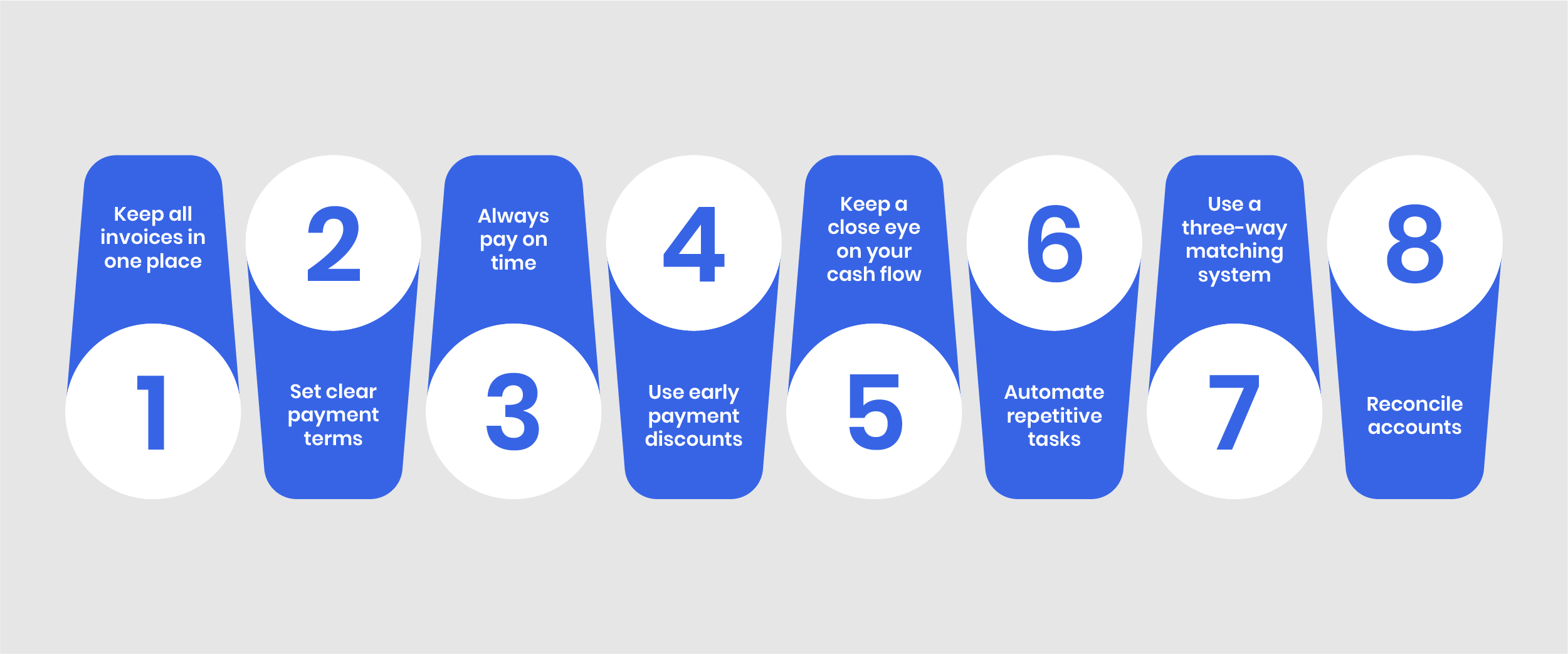Managing accounts payable helps keep your business finances strong. It keeps cash flowing, builds trust, and avoids payment stress. But when invoices pile up and approvals slow down, it can feel tough.
Businesses today must do more with less, seeking ways to cut costs and work efficiently. Better accounts payable frees up cash stuck in your accounts. This freed-up cash helps keep operations smooth, supports growth, and funds new opportunities. Strong accounts payable management is the foundation.
Startups can change the world, but many struggle. About 90% fail. In the first year, 20% of startups close. Many fail because of money problems. 82% say poor cash flow causes failure, and 29% run out of cash. This is often due to bad accounting. Startups often can’t hire accountants and try to manage money themselves. Good accounting can help fix this.
According to Forbes, Small businesses make up 100% of all U.S. businesses, with 33 million across the country. They play a main role in creating jobs and supporting the economy.
This guide gives easy tips to simplify accounts payable and help grow your business.
What is Accounts Payable Management?
Accounts payable management means handling all the money your business owes to vendors. It includes receiving, recording, approving, and paying invoices on time and accurately. A good AP process helps track cash flow and manage finances. Manage AP to avoid fees, build trust, and make smart decisions. It also makes your payment system more efficient and reliable.
If you don’t manage AP well, your business can have problems like missing discounts, paying bills twice, slower work, and more mistakes. Other common errors include not using sales orders and approving manually. Sometimes, orders are not properly checked. Vendor information can be messy, and payments may be slow. Incorrect supplier details and confusing approval processes also cause problems. Using automation tools can help fix these issues and make the process easier and faster.
According to Forbes, before, companies did all invoice work by hand, which took a lot of time. As of now, only 10% of businesses have automated this process. Most focus on sales and marketing, but now more see the benefits of AP. Usually, when buying, a supplier sends an invoice by mail. The company finds who bought it, gets approval, enters data, and mails a check. This can take 30 to 90 days. With AP automation, buyers send sale orders first. Suppliers send invoices, and the system checks them. The system also makes payments automatically. This saves time and cuts mistakes. Automation gives better control, saves work, reduces errors, and makes the process digital. Success needs a project leader, team support, and clear communication. AP automation helps companies work faster and smarter, letting teams focus on important tasks.
According to Bloomberg, Wall Street Missed Warning Signs Before $1 Billion Fintech Collapse. Citigroup and Natixis believed they were supporting a $1 billion fintech company called Stenn. But when Stenn suddenly failed in December, many of its supposed partners said they had never actually worked with the company. Each week before its collapse, Stenn emailed data on a $1 billion trade-finance deal. Major investors included Citigroup, BNP Paribas, Natixis, HSBC, Barclays, M&G, and Goldman Sachs.
Why is managing AP so important?
AP management plays a big role in your financial health. Managing payments well can help you get discounts or extra time to pay. This helps you save money and use your cash for other business needs.
But if AP is poorly managed, it can cause problems. Late payments can lead to penalties and damage your relationship with vendors. Over time, it harms your reputation, slows operations, and hurts finances.
Some companies delay payments to hold onto cash longer. While that might seem like a smart move, it can hurt your relationship with vendors. They may respond by:
- Slowing down deliveries
- Taking longer to fix issues
- Offering worse terms in the future
Paying early, but, can offer benefits like discounts and rewards. It also builds trust and reliability with your suppliers.
Benefits of Good AP Management
Effective AP management provides many benefits:
- Improves cash flow
- Helps with better planning and budgeting
- Reduces risk of running out of funds
- Boosts profitability
- Strengthens supplier relationships
Best Practices for Managing Accounts Payable
To manage AP, you need more than a to-do list. These eight practical tips will help you stay in control and get better results.
1. Keep all invoices in one place
Having invoices scattered in different places leads to confusion and mistakes. Use one system, a shared inbox or AP software to manage all invoices. Scan paper invoices immediately to track due dates, send reminders, and avoid missed payments. A single, organized system saves time and reduces errors.
2. Set clear payment terms
Agree with vendors on payment terms like net-30 or net-60. Write down these terms in a contract, email, or sheet. Clear terms prevent misunderstandings and ease payment planning.
3. Always pay on time
Late payments hurt your business. They lead to extra fees and damage the vendor trust. Sort invoices by due date and use reminders. Assign clear roles for fast approvals. Paying on time builds vendor trust.
4. Use early payment discounts
Some vendors offer 5–10% discounts for early payment within 10 days.
Check your vendor contracts for these deals. If your cash flow allows it, taking advantage of it adds up to big savings over time and improves your cash position.
5. Keep a close eye on your cash flow
Check cash flow with dashboards or forecasts to plan payments, adjust spending, or negotiate terms. This keeps your finances under control.
6. Automate repetitive tasks
Automation can make AP much easier. Start by entering invoices, matching them, and processing payments. Use AP software to scan invoices, route approvals, and schedule payments automatically. Even automating part of the process saves time and reduces mistakes.
7. Use a three-way matching system
This system checks that your order, delivery, and bill all match. It compares the sale order, delivery receipt, and invoice. Ask vendors to include sale order numbers on invoices. If something doesn’t match, pause the payment and investigate. Automation can speed up this process and catch errors before they become costly.
8. Reconcile accounts
Every month, compare your AP records to your bank statements. Look for duplicate payments, unpaid bills, or suspicious activity. Use a checklist or spreadsheet to stay organized. If your business handles a lot of invoices, use accounting software to make this step faster. Regular reviews help you catch errors early and keep your financial records accurate.
Signs You’re Ready to Automate AP
Here are five signs it’s time to upgrade your AP process:
- You’re still doing everything by hand
- Invoices take too long to process
- You often miss early payment savings
- You don’t have a clear view of vendor performance
- Your team spends a lot of time fixing AP errors
How to Track Your AP Performance
Once you improve your AP process, it’s important to measure the results. Here are four key metrics to track:
- Days Payable Outstanding (DPO): This shows how long it takes to pay your vendors. A higher DPO means you’re holding onto cash longer, but too high could hurt vendor relationships. Find a balance that supports your cash flow without delaying payments.
- Invoice Processing Time: Measure how long it takes to pay an invoice from the time you receive it. The faster your system, the more efficient your process is.
- Payment Accuracy: Keep track of how often you make mistakes like overpaying, underpaying, or paying twice. Accuracy matters and automation can help reduce errors.
- Number of Late Payments: Fewer late payments mean you’re managing AP well. If you see a pattern of delays, it’s time to improve your process.
A good AP system lets you track progress with reports, find improvements, and prove your efforts work.
You can use different kinds of software to help manage your money. This includes basic accounting, document storage, invoice/payment, and expense tracking tools. There are also systems to manage vendors and electronic payment options like ACH or virtual cards. Other helpful tools include reports, forecasts, and automation to make work easier.
Case Study
Coast Flight is a leading U.S. aviation school training commercial pilots. Each location handled purchases using spreadsheets. The team learned of purchases only when invoices arrived. Matching invoices to spreadsheets took days. Sale orders were often missing or wrong, causing extra work and confusion.
During COVID-19, Coast Flight began using new AP software to manage purchases. All buying goes through the software, giving accounting control and real-time updates. Approvals are automatic, and invoice mistakes are easy to spot. Invoices sync directly with QuickBooks, saving time and reducing errors. Coast Flight cut invoice processing time by 25–35%, freeing the team to focus on key tasks. This better system helps Coast Flight run smoothly while training future pilots.
Conclusion
Good AP management is more than paying bills; it helps you grow your business. Use the right tools and strong vendor ties to save money, speed work, and make smart financial choices. Start by setting clear steps and exploring automation tools. You’ll see the difference in how smoothly your business runs.
EA’s AP software speeds up and simplifies your accounts payable. Our system reduces manual work, speeds up approvals, and keeps your vendors happy. Expertise Accelerated cuts errors and saves time with smart tools. Want to see how it works? Watch a quick demo and discover how Expertise accelerated clients save an average of 5% per year.




